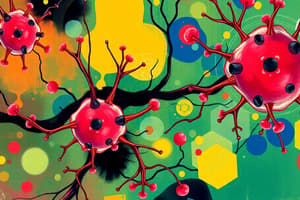Podcast
Questions and Answers
Flashcards
Drug Elimination in Alkaline Urine
Drug Elimination in Alkaline Urine
The process by which a drug is removed from the body through urine that has a higher pH than normal.
Enzyme Inhibitor
Enzyme Inhibitor
A substance that slows down or prevents the activity of an enzyme, a protein that catalyzes chemical reactions in the body.
Drug-Drug Interaction: Synergism
Drug-Drug Interaction: Synergism
When two drugs taken together produce an effect greater than the sum of their individual effects.
Noradrenaline Receptor
Noradrenaline Receptor
Signup and view all the flashcards
Isoproterenol Action
Isoproterenol Action
Signup and view all the flashcards
Drug Elimination in Acidic Urine
Drug Elimination in Acidic Urine
Signup and view all the flashcards
Adrenaline: Local Hemostatic & Nasal Decongestant
Adrenaline: Local Hemostatic & Nasal Decongestant
Signup and view all the flashcards
Bioavailability
Bioavailability
Signup and view all the flashcards
Drug-Drug Interaction: Pharmacokinetic
Drug-Drug Interaction: Pharmacokinetic
Signup and view all the flashcards
Intrathecal Route of Administration
Intrathecal Route of Administration
Signup and view all the flashcards
Drug-Drug Interaction: Pharmacodynamic
Drug-Drug Interaction: Pharmacodynamic
Signup and view all the flashcards
Drug Conjugation
Drug Conjugation
Signup and view all the flashcards
Drug Half-Life (t1/2)
Drug Half-Life (t1/2)
Signup and view all the flashcards
Drug Bioavailability Explained
Drug Bioavailability Explained
Signup and view all the flashcards
Drug Agonist
Drug Agonist
Signup and view all the flashcards
Dopamine & Adrenaline Receptor Activation
Dopamine & Adrenaline Receptor Activation
Signup and view all the flashcards
Drug-Drug Interaction: Chemical Antagonism
Drug-Drug Interaction: Chemical Antagonism
Signup and view all the flashcards
Nasal Decongestant: Adrenaline
Nasal Decongestant: Adrenaline
Signup and view all the flashcards
Pharmacodynamics
Pharmacodynamics
Signup and view all the flashcards
Dual-Acting Adrenergic Drugs: Tachyphylaxis
Dual-Acting Adrenergic Drugs: Tachyphylaxis
Signup and view all the flashcards
Bioavailability: Importance
Bioavailability: Importance
Signup and view all the flashcards
Noradrenaline Release Enhancement: Amphetamine
Noradrenaline Release Enhancement: Amphetamine
Signup and view all the flashcards
Isoprenaline Receptor Activation
Isoprenaline Receptor Activation
Signup and view all the flashcards
Drug Excretion: Alkalinization of Urine
Drug Excretion: Alkalinization of Urine
Signup and view all the flashcards
Cumulative Effect: Toxicity
Cumulative Effect: Toxicity
Signup and view all the flashcards
Adrenaline Metabolism: MAO & COMT
Adrenaline Metabolism: MAO & COMT
Signup and view all the flashcards
Local Anesthetic Duration Prolongation: Adrenaline
Local Anesthetic Duration Prolongation: Adrenaline
Signup and view all the flashcards
Drug Biotransformation Outcome
Drug Biotransformation Outcome
Signup and view all the flashcards
Drug Interaction: Additive Effect
Drug Interaction: Additive Effect
Signup and view all the flashcards
Enzyme Inducer
Enzyme Inducer
Signup and view all the flashcards
Study Notes
Pharmacology Review Questions
-
Drug Elimination in Urine: Sulfonamide is eliminated in alkaline urine, while amphetamine is eliminated in acidic urine.
-
Enzyme Inhibitors: Tobacco smoking is an enzyme inhibitor.
-
Drug Interactions: Combining drugs can lead to drug accumulation, synergism (enhanced effect), tachyphylaxis (rapid decrease in drug response), or tolerance (resistance to drug's effect).
-
Noradrenaline Receptors: Noradrenaline can activate both alpha and beta receptors, not just one type.
-
Isoproterenol Action: Isoproterenol is a sympathomimetic drug acting directly on beta-adrenergic receptors.
-
Local Hemostatic/Nasal Decongestant: Adrenaline is a local hemostatic, nasal decongestant, and direct-acting catecholamine.
-
Bioavailability: Bioavailability refers to the fraction of an uncharged drug reaching the systemic circulation after administration, regardless of the route.
-
Drug-Drug Interaction Types: Pharmacokinetic interactions affect absorption, biotransformation, distribution, and excretion.
-
Drug Administration Routes: The intra-thecal route is preferred for administering drugs directly into the spinal cord.
-
Conjugation: Conjugation is the process of coupling a drug with an endogenous substrate, such as glucuronic acid.
-
Drug Half-Life (t 1/2): The half-life (t1/2) is the time needed for a drug in plasma to reduce by half during elimination.
-
Agonist Definition: An agonist is a drug that binds to a receptor and initiates specific effects(changes in cell function.)
-
Chemical Antagonism Definition: Chemical antagonism is when one drug combines with another to form an inactive compound.
-
Additional Pharmacology Terms and Definitions: The remaining questions cover various pharmacology concepts, including drug actions, mechanisms of action, drug interactions, clinical uses, and more. These details are crucial for comprehensive drug knowledge.
Studying That Suits You
Use AI to generate personalized quizzes and flashcards to suit your learning preferences.




